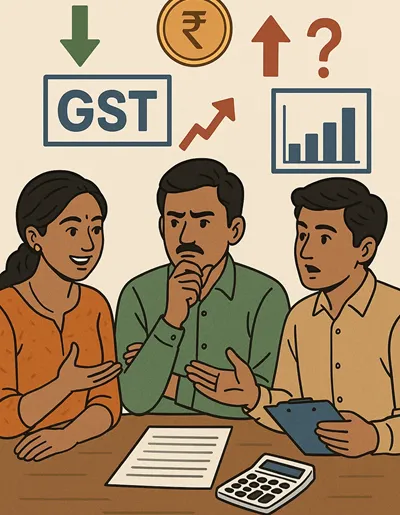
Overview
The 56th GST Council Meeting (September 2025) introduced India's biggest GST overhaul since 2017. The reform simplifies the tax structure, reduces rates on essentials, and hikes taxes on luxury and harmful products.
The new structure focuses on two main slabs — 5% and 18%, with essentials being nil-rated and sin goods taxed up to 40%.
Key Highlights of GST Reform 2025
| Category | Earlier Rate | New Rate | Remarks |
|---|---|---|---|
| Essentials (soap, toothpaste, bread, paneer, butter, cheese) | 12% / 5% | Nil / 5% | Major relief for consumers |
| Life-saving drugs | 5% / 12% | Nil | Fully exempted |
| Other medicines | 12% | 5% | Affordable healthcare |
| Farm machinery, irrigation tools | 12% | 5% | Boost to agriculture |
| Renewable energy equipment | 12% | 5% | Supports green energy |
| Two-wheelers (≤ 350 cc), small cars, TVs, ACs, dishwashers | 28% | 18% | Encourages middle-class demand |
| Tobacco, pan masala, gutkha, aerated drinks | 28% + cess | 40% | Discourages harmful consumption |
Institutional & Practical Reforms
- The GST Appellate Tribunal (GSTAT) will be operational by December 2025 for faster dispute resolution.
- Simplified annual returns for businesses.
- Old stock (before 22 Sept 2025) can be sold without changing price stickers.
- Rail Neer water bottles get cheaper—GST cut from 18% to 5%.
Why These Changes?
- To simplify GST into fewer slabs.
- To make essentials and medicines affordable.
- To boost consumer spending on mid-range goods.
- To discourage tobacco and luxury product consumption.
- To reduce litigation through a new GSTAT system.
Where to Check Official Notifications
- Press Information Bureau (PIB): pib.gov.in → Press Releases → GST Council
- GST Council: gstcouncil.gov.in → Press Releases & Decisions
- CBIC GST Notifications: cbic-gst.gov.in → GST Law → Notifications
For other states, visit https://cbic-gst.gov.in → "Helpdesk / Contact Us" section.
Where to Complain
- If retailers don't reduce prices after rate cuts or charge incorrect GST:
- File a complaint on consumerhelpline.gov.in or the INGRAM app.
- You can also reach out to your State GST Department or CBIC Anti-profiteering Unit.
FAQs on GST Reform 2025
-
1. What are the new GST slabs?
-
Now two main slabs — 5% and 18%. Essentials may be nil, while luxury and sin goods attract 40%.
-
2. Which items became cheaper?
-
TVs, ACs, motorcycles, soaps, toothpaste, butter, paneer, cheese, and most medicines.
-
3. Which goods became costlier?
-
Tobacco, pan masala, gutkha, and aerated drinks.
-
4. How much GST on medicines now?
-
Life-saving drugs → Nil; Other medicines → 5%.
-
5. Is paneer tax-free now?
-
Yes, pre-packaged paneer is nil-rated.
-
6. Are small cars and bikes cheaper?
-
Yes. Two-wheelers (≤350cc) and small cars now taxed at 18% (down from 28%).
-
7. Any benefit for farmers?
-
Yes, GST on farm machinery and irrigation tools reduced to 5%.
-
8. Renewable energy equipment?
-
Cheaper now — GST cut to 5%.
-
9. Do I need to change old stock stickers?
-
No, goods made before 22 Sept 2025 can be sold with existing MRP.
-
10. Where can I check official rate lists?
-
On pib.gov.in and gstcouncil.gov.in.
-
11. What is GSTAT?
-
A new tribunal to handle GST appeals quickly — starts functioning December 2025.
-
12. How does it impact government revenue?
-
Estimated shortfall ₹48,000 crore, but higher demand is expected to offset it.
-
13. Can I report overcharging?
-
Yes, through Consumer Helpline (1800-11-4000) or consumerhelpline.gov.in.
-
14. What about hotels or luxury services?
-
Higher slabs apply for luxury tariffs and services above certain price limits.
-
15. Is bread still tax-free?
-
Yes, remains nil-rated.
Add new comment